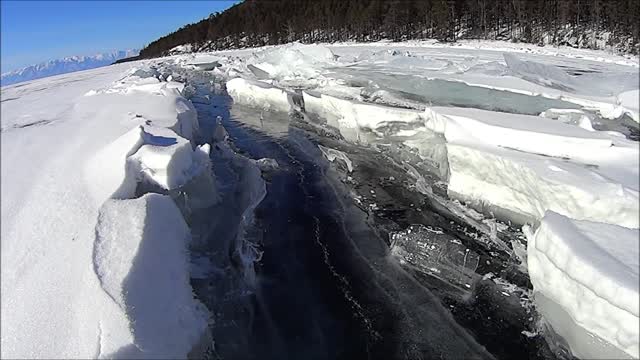Premium Only Content

Largest Natural Ice sound..its awsome....
On the prowl for food, Adelie penguins scan the ice ceiling. They peck at silverfish and hunt for polynyas, gaping holes in the sea ice where shoals of krill and bug-like copepods graze on clouds of algae. When spring comes, the huge plates of sea ice start to melt and later in the brief Antarctic summer all but disappear. Then, algae blooms unfurl: a bacchanalian feast for krill and critters all the way up the Antarctic food chain. Sea ice, sunlight, and food—they all come and go with the seasons in the Southern Ocean.
Paul Holland, a climate modeler with the British Antarctic Survey, has spent the last ten years studying Antarctica’s sea ice and the Southern Ocean. Lately, he has been scrutinizing the seasons of Antarctica and how fast the ice comes and goes. Holland thinks these seasons may be a key to a conundrum: If Earth’s temperatures are getting warmer and sea ice in the Arctic has been shrinking fast, why then is sea ice in the Antarctic slowly increasing? Sea ice is simply frozen seawater. Although found only in the Arctic and the Antarctic, it influences Earth’s climate in big ways. Its bright surface reflects sunlight back into space. Icy areas absorb less solar energy and remain relatively cool. When temperatures warm over time and more sea ice melts, fewer bright surfaces reflect sunlight back into space. The ice and exposed seawater absorb more solar energy and this causes more melting and more warming.
Photograph of sea iceThis scene shows a mixture of sea ice types commonly seen in the Southern Ocean. The different thicknesses of sea ice form a spectrum of colors and shapes ranging from dark black open water, a thin grease-like covering called grease ice, and thicker grey ice. Older sea ice has a bright white covering of snow and many chaotic deformation features visible as ridges and rubble fields caused by the continuous motion of the ice pack. (Courtesy M. Studinger/NASA)
Scientists have been watching this feedback loop of warming and melting in the Arctic. To them, Arctic sea ice is a reliable indicator of a changing global climate. They pay the most attention in September when Arctic sea ice shrinks to its smallest extent each year. Measured by satellites since 1979, this minimum extent has been decreasing by as much as 13.7 percent per decade. Antarctic sea ice, on the other hand, has not been considered a climate change indicator. Whereas Arctic sea ice mostly sits in the middle of land-locked ocean—which is more sensitive to sunlight and warming air—Antarctic sea ice surrounds land and is constantly exposed to high winds and waves.
According to climate models, rising global temperatures should cause sea ice in both regions to shrink. But observations show that ice extent in the Arctic has shrunk faster than models predicted, and in the Antarctic it has been growing slightly. Researchers are looking much closer at Antarctica, saying, “Wait, what is going on down there?”
-
 49:45
49:45
BonginoReport
4 hours agoTrump’s Cryptic Putin Threat (NEW STUDIO) (Ep.155) - 03/07/2025
69.7K107 -
![🔴[LIVE] Breaking Market News, Powell Conference & Trump Speech || The MK Show](https://1a-1791.com/video/fwe2/c1/s8/1/4/f/p/q/4fpqy.0kob-small-The-MK-Show-Mar.-7th.jpg) LIVE
LIVE
Matt Kohrs
10 hours ago🔴[LIVE] Breaking Market News, Powell Conference & Trump Speech || The MK Show
1,493 watching -
 LIVE
LIVE
Wendy Bell Radio
6 hours agoWho's Your Daddy?
13,794 watching -
 1:38:45
1:38:45
Jeff Ahern
2 hours ago $1.21 earnedFriday Freakout with Jeff Ahern (Dems Keep Losing)
12.9K2 -
 1:11:37
1:11:37
LFA TV
14 hours agoThe MOST PRECIOUS Commodity of ALL!! | WORLD HD 3.7.25 8AM
32.8K1 -
 10:25
10:25
Melonie Mac
22 hours agoThe Last of Us 3 won't be happening by the look of it
49.5K55 -
 14:50
14:50
Mrgunsngear
22 hours ago $6.62 earnedRuger LC Carbine 10mm Review 🇺🇸
50.7K35 -
 15:17
15:17
Degenerate Jay
1 day ago $8.44 earnedThis Batman Keeps Coming Back!
47K16 -
 37:38
37:38
Kyle Rittenhouse Presents: Tactically Inappropriate
15 hours ago $3.54 earnedThe Dinesh D'souza Interview
41.1K3 -
 12:18
12:18
NinjaGamblers
1 day ago $2.31 earnedHow to Win at Roulette with The Three-Layered Castle Strategy
38.7K6